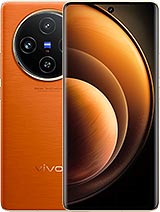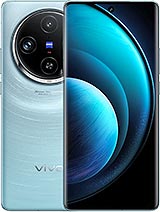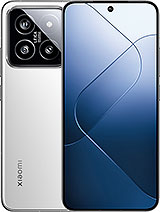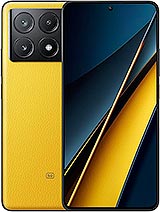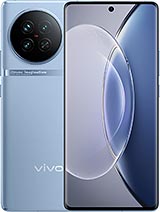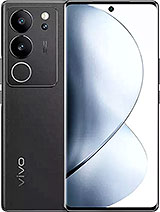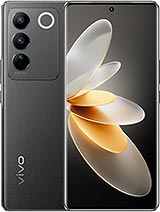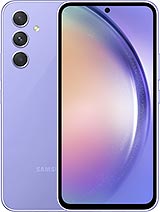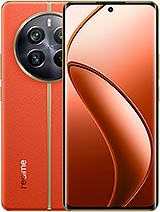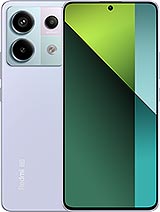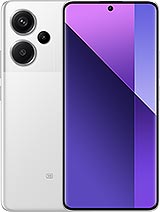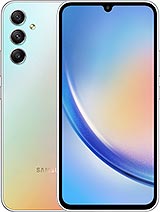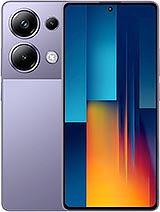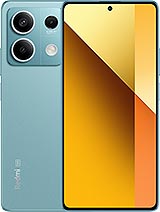vivo V30 Pro review

Funtouch OS 14 on top of Android 14
The vivo V30 Pro runs Android 14 with a layer of the in-house layer Funtouch OS 14 on top. It's a pretty familiar software package that we've already seen on other devices like the vivo X100 Pro and, in turn, fairly similar to the previous Funtouch, but not entirely unchanged.
Vivo promises it will deliver two major OS updates and three years of security patches for the V30 Pro, like on other V-series devices.

In v14, Funtouch differs from stock Android in terms of stylistic choices, although vivo has now adopted Google's large bubbles for some of the quick toggles - but just one row of them.
There are many custom UI bits here and there, like the recent apps menu, which can be switched between a standard carouse and a two-row tile layout. Both the lock screen and home screen also have plenty of custom bits, including all sorts of animation effects. There are three different clock styles and eight different fonts to choose from on the lock screen.

The app drawer has an expandable recommended apps category on the top (most commonly used ones), whereas using the vertical scroller on the right would highlight the apps beginning with the selected letter.

Funtouch OS has plenty of quick shortcuts and actions to customize as well. Holding the volume down key can be used to launch an app or do a certain task. There is also an optional Smart Sidebar with quick shortcuts.
Vivo also includes plenty of first-party apps within Funtouch OS. A dedicated Ultra Game Mode and an Albums app, Music, Themes and iManager are available.
The vivo V30 Pro comes with a "50-Month Smooth Experience" guarantee. Admittedly, that sounds very vague, but vivo promises that they have thoroughly optimized both the software and hardware and have verified that the phone will maintain its fluid operation for over four years.
Benchmarks and performance
The vivo V30 Pro is based on a MediaTek Dimensity 8200 chipset. That's a pretty high-end part made on a modern 4nm manufacturing node. That being said, it is being carried forward from the vivo V29 Pro and the V27 Pro before that, so don't expect a boost in general performance generation over generation.
In terms of CPU, the Dimensity 8200 has one prime Cortex-A78 core, clocked at up to 3.3 GHz, another three Cortex-A78 ones, working at up to 3.0 GHz and a total of four smaller and more energy-efficient Cortex-A55 cores, rated for 2.0 GHz.
A Mali-G610 MC6 GPU handles graphics.

The vivo V30 Pro is globally available with 12GB of 3200 MHz LPDDR5 RAM. That has an additional 12GB of virtual memory on top. That is paired with either 256GB or 512GB of UFS 3.1 storage. Sadly, non-expandable.
There is also an India-exclusive version with 8GB of RAM (plus 8GB virtual memory) and 256GB of storage.
Our review unit is the top-of-the-line 12GB/512GB version.
Let's kick things off with some CPU tests and GeekBench. The Dimensity 8200 is not exactly the "cream of the crop" anymore, but it still holds its own pretty well. Sure, a modern flagship Dimensity 9300 or a Snapdragon 8 Gen 3 will manage nearly double the single-core scores, but in practical terms, the Dimensity 8200 has plenty of CPU power to throw around. Definitely better than popular mid-range chips like the Snapdragon 7s Gen 2 or the Snapdragon 778G.
AnTuTu is a much more compound benchmark that includes GPU and memory tests. We are happy to see the vivo V30 Pro pretty high up on the list, outpacing its vivo V29 Pro predecessor slightly (in V10), but still with a measurable margin. Again, you aren't realistically getting true 2024 flagship performance, but there is plenty of power to go around.
The Mali-G610 MC6 holds up quite well in 2024 in terms of raw performance. Again, it manages to outperform most popular mid-range chips in the same price range.
We've discontinued GFXBench graphics benchmarking as the app is often banned/blacklisted on the phones we receive for review. The graphics performance ranking in 3D Mark is just as meaningful, so we suggest you refer to that one instead.
The only real issue we encountered while testing the Mali-G610 MC6 inside the Dimensity 8200 was its inability to run the 3DMark Solar Bay test, which is kind of odd given that the Solar Bay test uses the Vulkan 1.1 API and ray tracing on Android devices and, as far as we can tell, the Dimensity 8200 and Mali-G610 MC6 support Vulkan 1.3. This is hardly a dealbreaker, though.
In more practical terms, we found the vivo V30 Pro to be an excellent all-around performer. Despite rocking the same chipset as its predecessor and that phone's predecessor as well, we believe it is not starved for power in any noticeable way. The UI runs smoothly with no slowdowns or hiccups, and the phone easily handles daily tasks and even some fairly demanding games.
Even though the decision to stick with the same chipset for a third generation in a row looks admittedly unusual, it is honestly not harming the V30 Pro in any substantial way.
Thermal-throttling
The vivo V30 Pro advertises something vivo is calling an "Ultra Large Smart Cooling System". We aren't quite sure about all of its intricacies, but it does seem to include a self-described "large vapor chamber". In practice, the V30 Pro handles heat reasonably well.
Prolonged stress testing eats away a substantial chunk of the phone's performance, but all of the thermal throttling occurs gradually and in a nice and controlled manner with no major jarring stutters. That's generally what you want to see.
Plus, the phone's surface remains warm and never uncomfortable to hold or touch, even after prolonged stress testing. So, the comfort is there.
Connectivity
The V30 Pro is a dual-SIM 5G device with SA/NSA Sub.6 connectivity on both SIM slots. It also has dual-band Wi-Fi 6 (ax) and Bluetooth 5.3 with LE support. There is GPS, GLONASS, BDS, GALILEO, QZSS and NavIC for positioning.
We already noted the lack of expandable storage. The V30 Pro also lacks a 3.5mm audio jack. There is NFC, though.
The Type-C port on the V30 Pro is backed up by a basic USB 2.0 connection, which means a theoretical maximum transfer rate of 480 Mbps. It has USB Host/OTG support but nothing fancy beyond that, like video output.
In case you were wondering, the phone has no notification LED or Infrared blaster.

In terms of sensors, the V30 Pro has an Ism6dso accelerometer and gyroscope combo, a sensorTek stk36c31 light and a memsic mmc5603 magnetometer and compass combo. There is no barometer onboard.
Unfortunately, as far as we can tell, the vivo V30 Pro seems to be using a virtual proximity sensor. At least kind of. There does seem to be an actual hardware proximity sensor on board since the phone manages to turn off its display during calls using the default dialer just fine. However, readings from said sensor appear to be unavailable onside of the dialer and to any third party apps which is not ideal.
Reader comments
- david
- 11 Sep 2024
- 7k3
waterproof ???????
- Anonymous
- 21 Jul 2024
- X@1
It's pretty much in the same class. 13T should be compared to V30 though since the price is much more similar.
- Anonymous
- 21 Jul 2024
- X@1
Current pricing is understatement. In my market V30 Pro goes for $550 while 13T goes for $400.
